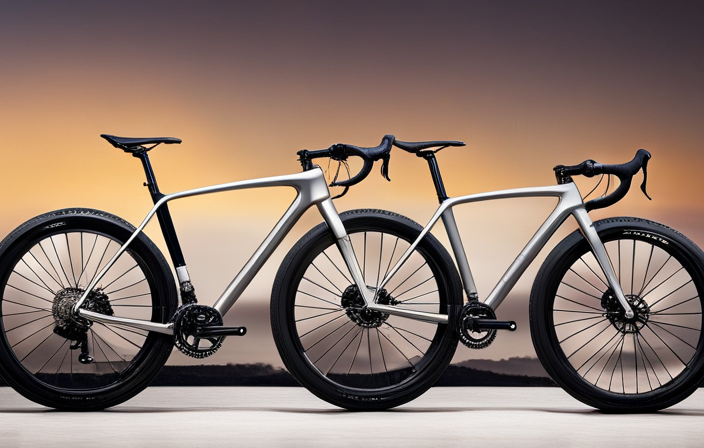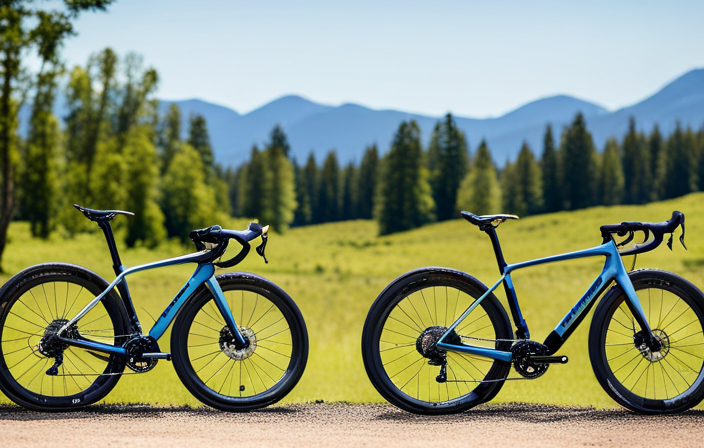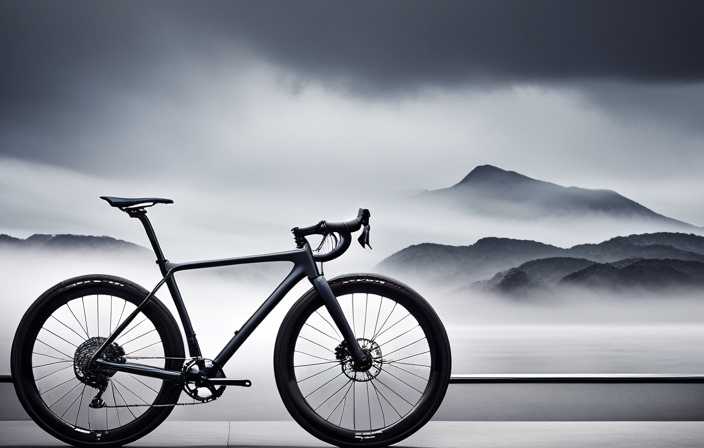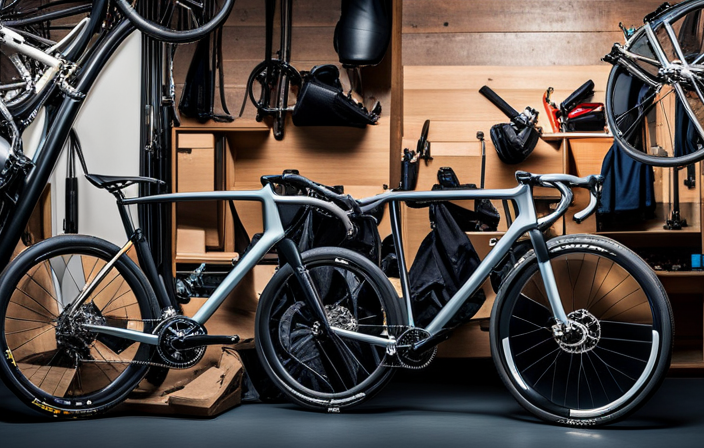Have you ever wondered which gravel bike frame size is the ideal match for you? Selecting the correct frame size is essential for maximum comfort and performance.
In this article, we will delve into the importance of selecting the correct frame size and explore various factors to consider when determining your ideal fit.
By understanding frame geometry, utilizing bike size charts, and trying out different sizes, you’ll be well-equipped to make an informed decision and find the gravel bike frame that suits your needs perfectly.
Key Takeaways
- Proper bike fit ensures comfort, efficiency, and performance
- Factors to consider when determining frame size include body measurements, material and flexibility of the frame, and recommendations from bike fit specialists
- Understanding frame geometry helps in making an informed decision about the right frame size
- Using bike size charts and calculators, trying out different frame sizes, and consulting with bike fit specialists are important steps in finding the optimal gravel bike frame size.
Importance of Choosing the Right Frame Size
Choosing the right frame size for your gravel bike is crucial. The importance of bike fit cannot be overstated. A properly fitted bike ensures optimal comfort, efficiency, and performance while riding. When it comes to gravel bikes, which are designed for off-road adventures, the impact of incorrect frame size can be even more pronounced.
If your gravel bike frame is too small, you may experience discomfort and limited range of motion. This can lead to inefficient pedaling and decreased power transfer to the wheels. On the other hand, if the frame is too large, you may struggle to maintain control over rough terrain and find it difficult to maneuver.
An incorrectly sized frame can also put unnecessary strain on your body, leading to discomfort or even injury in the long run. It’s important to consider factors such as leg inseam length, torso length, and arm reach when determining the appropriate frame size for your gravel bike.
Next, we will delve into various factors that should be taken into account when determining the ideal frame size for your gravel bike. These considerations will ensure a comfortable and enjoyable riding experience without compromising control or performance.
Factors to Consider When Determining Frame Size
Deciding on the appropriate gravel bike frame involves taking into account various factors. One of the most important considerations is consulting with bike fit specialists who can assess your body measurements and recommend the right frame size for you. They will take into consideration your height, inseam length, and arm reach to determine the optimal frame size.
Another factor to consider when determining frame size is the material and flexibility of the frame. Different materials, such as aluminum, carbon fiber, or titanium, have varying degrees of flexibility. This affects how comfortable and efficient your ride will be. For example, a stiffer frame may provide better power transfer but can also be less forgiving on rough terrains.
To help you visualize these factors, here is a table summarizing some key aspects to consider:
| Factor | Importance |
|---|---|
| Body Measurements | Recommended by bike fit specialists |
| Frame Material | Determines comfort and efficiency |
| Flexibility | Affects ride quality |
Considering these factors when determining your gravel bike frame size will ensure that you have a comfortable and enjoyable riding experience. Understanding how each factor contributes to your overall fit is crucial in finding the perfect match for you.
Moving forward to understanding frame geometry…
Understanding Frame Geometry
Understanding frame geometry is essential for finding the right fit and comfort in your cycling experience. When it comes to bike fit, frame sizing plays a crucial role. Frame geometry refers to the angles and dimensions of a bike’s frame, which greatly affect how it handles and feels on the road or trail.
One important aspect of frame geometry is the stack and reach measurements. The stack measurement represents the vertical distance from the bottom bracket to the top of the head tube, while reach measures the horizontal distance between these two points. These measurements determine how upright or stretched out you’ll be on the bike.
Another key factor in frame geometry is the wheelbase length. This refers to the distance between the front and rear axles. A longer wheelbase offers more stability but sacrifices maneuverability, while a shorter wheelbase provides quick handling at the expense of stability.
Lastly, consider factors such as head tube angle, seat tube angle, and chainstay length when examining frame geometry. These elements influence steering responsiveness, weight distribution, and power transfer efficiency.
Understanding these technical aspects of frame geometry will help you make an informed decision when choosing your gravel bike size. Now that we have covered this topic thoroughly, let’s move on to using bike size charts and calculators for further guidance in finding your perfect fit without any guesswork involved.
Using Bike Size Charts and Calculators
To ensure a proper fit, you can utilize bike size charts and calculators that provide guidance on finding the right size for your cycling needs. These tools take into account various factors such as your height, inseam length, and arm reach to recommend the appropriate frame size for you.
Here are four key benefits of using bike size charts and calculators:
-
Accurate Sizing: Bike size calculators use precise measurements to determine the ideal frame size based on your body proportions. This ensures a comfortable riding position and optimal power transfer.
-
Consistency Across Brands: Different bike manufacturers may have slightly different sizing standards. By using a bike size chart or calculator, you can compare sizes across brands and find consistency in fit.
-
Time Saving: Instead of physically trying out multiple bikes in different sizes, using a size chart or calculator can help narrow down your options before visiting a bicycle shop.
-
Online Convenience: Many retailers offer online tools that allow you to input your measurements and receive instant recommendations without leaving the comfort of your home.
By utilizing these resources, you can make an informed decision when choosing the correct gravel bike frame size for yourself. Once armed with this knowledge, you can confidently move on to trying out different frame sizes to find the perfect match for your riding style and preferences.
Trying Out Different Frame Sizes
When trying out different frame sizes, it’s important to focus on finding the right fit for your body proportions and riding style. Evaluating comfort and finding the optimal fit can greatly enhance your riding experience on a gravel bike. One way to determine which frame size suits you best is by using a sizing chart or calculator as mentioned in the previous subtopic. However, another effective method is physically trying out different frame sizes.
To help you understand the importance of finding the right fit, consider this table below:
| Frame Size | Rider Height Range |
|---|---|
| Small | 5’2" – 5’6" |
| Medium | 5’6" – 5’10" |
| Large | 5’10" – 6’2" |
By testing various frame sizes, you can assess how each one feels when you ride. Pay attention to factors such as reach, stack height, and standover height. These measurements will affect your posture and overall comfort while cycling. Take note of any discomfort or restrictions in movement that may arise from an ill-fitting frame.
Once you have evaluated different sizes and have an idea of what works best for you, it’s time to consult with bike fit specialists who can further refine your setup and make adjustments based on your unique body mechanics and preferences.
Transitioning into consulting with bike fit specialists allows for a more personalized approach in achieving the ideal gravel bike frame size for your needs without solely relying on trial-and-error methods.
Consulting with Bike Fit Specialists
Once you’ve determined the right fit through trial and error, consulting with bike fit specialists can provide personalized adjustments for optimal comfort on your gravel rides.
Bike fitting is a meticulous process that takes into account various factors, such as your body measurements, flexibility, riding style, and specific goals.
Here are three benefits of professional bike fitting:
-
Enhanced Efficiency: A professional bike fit ensures that your body is properly aligned on the bike, allowing for efficient power transfer and reducing energy wastage. This optimization can lead to improved speed and endurance during long gravel rides.
-
Injury Prevention: Proper bike fit helps to minimize the risk of common cycling injuries by ensuring proper alignment and reducing strain on vulnerable areas such as knees, back, neck, and shoulders. A specialist can make necessary adjustments to alleviate discomfort or pain caused by incorrect positioning.
-
Increased Comfort: A well-fitted bike will provide superior comfort throughout your rides. By making precise adjustments to components like saddle height, handlebar reach, and cleat position, a bike fit specialist can help alleviate pressure points and reduce fatigue.
Consulting with a professional not only enhances your riding experience but also helps prevent potential injuries. Once you have undergone a comprehensive bike fitting session with an expert, you’ll be ready to move onto adjusting and fine-tuning your bike fit for further customization.
Adjusting and Fine-Tuning Your Bike Fit
Make sure you take the time to fine-tune and adjust your bike fit for maximum comfort and performance. Proper bike fit adjustments can make a world of difference in your riding experience. By making small tweaks to your bike’s setup, you can avoid discomfort and potential injuries.
To help you get started on adjusting your bike fit, here is a table that outlines some key measurements and how they affect your riding position:
| Measurement | Effect on Riding Position |
|---|---|
| Saddle Height | Determines proper leg extension during pedaling |
| Handlebar Reach | Affects upper body posture and reach to handlebars |
| Stem Length | Influences overall bike handling and steering responsiveness |
| Cleat Position | Determines foot alignment on the pedals |
By carefully considering these measurements, you can ensure that your body is properly aligned with the bike, minimizing strain on your joints and maximizing power transfer.
Now that you have an understanding of how to adjust your bike fit, it’s important to consider other factors like frame material and flexibility. These aspects will further impact your comfort and performance on the gravel trails.
Considering Frame Material and Flexibility
When considering frame material for a gravel bike, it’s important to weigh the pros and cons of aluminum, carbon, and steel options.
Aluminum frames are lightweight and stiff, providing efficient power transfer but can be less comfortable on rough terrain.
Carbon frames offer excellent vibration damping properties for a smoother ride, but they can be more expensive.
Steel frames are known for their durability and flexibility, absorbing road vibrations well but being slightly heavier than the other options.
Ultimately, choosing the right frame material depends on your riding style and preferences for both stiffness and comfort.
Aluminum, Carbon, or Steel Frames
Although all three types of frames have their advantages, it’s important to consider whether aluminum, carbon, or steel is the best choice for your gravel bike. Each frame material has its own set of pros and cons that can affect the performance and durability of your bike. To help you make an informed decision, I have created a comparison table below:
| Frame Material | Pros | Cons |
|---|---|---|
| Aluminum | Lightweight, affordable | Less comfortable, can be stiff |
| Carbon | Lightweight, absorbs vibrations well | Expensive, prone to damage |
| Steel | Durable, provides a smooth ride | Heavier than other options |
When choosing a frame material for your gravel bike, it’s essential to consider factors such as weight, comfort, durability, and cost. This will ensure that you select the right option that aligns with your specific needs and preferences. Now let’s delve into the next section about frame stiffness and comfort without delay.
Frame Stiffness and Comfort
Frame stiffness and comfort are important factors to consider when choosing a frame material for your gravel bike.
Frame stiffness refers to the ability of the frame to resist flexing under load, providing better power transfer and handling. Aluminum frames are known for their stiffness, offering a responsive ride that efficiently transfers your pedaling effort into forward motion.
Carbon frames can also be stiff while providing a smoother, more comfortable ride due to their ability to absorb vibrations. On the other hand, steel frames offer excellent comfort by dampening road vibrations but may lack the same level of stiffness as aluminum or carbon.
When evaluating frame size for different types of riding, it’s crucial to find the right balance between comfort and performance without compromising your riding style or preferences.
Evaluating Frame Size for Different Types of Riding
To determine the right size gravel bike frame for your needs, it’s important to consider the type of riding you’ll be doing. Different types of riding require different frame sizes in order to optimize performance and comfort. When it comes to mountain biking, a smaller frame size is generally preferred as it provides better maneuverability and control on technical trails. On the other hand, road cycling typically benefits from a larger frame size that allows for a more aerodynamic position and efficient pedaling.
To illustrate this further, let’s take a look at the table below which outlines recommended frame sizes based on rider height for both mountain biking and road cycling:
| Rider Height | Frame Size (Mountain Biking) | Frame Size (Road Cycling) |
|---|---|---|
| 5’0" – 5’4" | XS/S | XXS/XS |
| 5’4" – 5’8" | S/M | XS/S |
| 5’8" – 6’0" | M/L | S/M |
| 6’0" – 6’4" | L/XL | M/L |
| >6’4” | XL/XXL | L/XL |
By considering these recommended frame sizes based on your height and intended riding style, you can ensure a more comfortable and efficient ride. However, it’s important to note that these recommendations are just guidelines and seeking advice from experienced riders or professionals can provide valuable insights into finding the perfect fit. Transitioning into the next section about ‘seeking advice from experienced riders’, remember that obtaining input from those with firsthand experience can be invaluable when selecting an ideal gravel bike frame size.
Seeking Advice from Experienced Riders
When seeking advice from experienced riders, I highly recommend checking out online forums and cycling communities. These platforms provide a wealth of knowledge and insights from cyclists who have been riding for years.
You can ask questions, share your concerns, and get valuable feedback on various topics related to gravel biking.
Additionally, joining local cycling clubs or groups is another great way to connect with experienced riders in your area. They often organize group rides where you can learn from their expertise and gain practical tips specific to your region’s terrain and conditions.
By tapping into these resources, you’ll be able to gather a wealth of information that can help you make informed decisions about frame size and other aspects of gravel biking.
Online Forums and Cycling Communities
While browsing online forums and cycling communities, it’s helpful to seek advice on determining the right size gravel bike frame. These platforms provide a wealth of knowledge from experienced riders who have already gone through the process of finding their ideal frame size. By engaging with these online communities, you can tap into a network of experts willing to share their insights and recommendations.
To make it easier for you, here is a table summarizing some key considerations when choosing your gravel bike frame size:
| Factor | Measurement | Ideal Range |
|---|---|---|
| Inseam Length | Measure from crotch to floor | 75-80% of inseam |
| Height | Measure without shoes | Size chart |
| Reach | Measure shoulder to fingertips | Varies based on preference |
By utilizing the expertise available in online forums and cycling communities, you can confidently determine the right size gravel bike frame for your needs. Moving forward, let’s explore how local cycling clubs and groups can also assist in this process.
Local Cycling Clubs and Groups
Joining local cycling clubs and groups can be a valuable resource for finding the right fit for your gravel bike. These clubs often organize local cycling events, such as group rides, which can provide you with an opportunity to test different frame sizes and get feedback from experienced riders. Group rides allow you to ride alongside others who may have similar bikes or face similar challenges, giving you a chance to observe and learn from their experiences.
Additionally, riding in a group can help you improve your skills and fitness level by pushing yourself to keep up with other riders. By participating in these group activities, you can gain insights into what size gravel bike frame would suit your needs best.
Moving on to budget considerations for frame size…
Budget Considerations for Frame Size
To determine the right size gravel bike frame for you, consider your budget and choose a frame that fits within your price range. When it comes to frame size affordability, there are several cost-effective options available that can meet your needs without breaking the bank. Here are four key factors to consider when thinking about budget considerations for frame size:
-
Material: Different frame materials have varying costs, with aluminum frames generally being more affordable than carbon fiber frames. Aluminum frames offer durability and stiffness at a lower price point.
-
Brand: Popular brands often come with higher price tags due to their reputation and demand. However, there are lesser-known brands that offer good quality frames at more affordable prices.
-
Frame Components: The components used in the frame construction can significantly affect its cost. Opting for basic or entry-level components can help keep the overall price down while still ensuring a reliable ride.
-
Used vs New: Purchasing a used gravel bike frame can be an excellent way to save money while still getting a high-quality product. Just make sure to thoroughly inspect the frame for any signs of damage or wear.
Considering these budget considerations for frame sizes will help you find an affordable option that meets your requirements without compromising on quality or performance.
Transitioning into considering frame size adjustability and future needs, it’s important to also factor in how adaptable the chosen frame is as your cycling preferences evolve over time.
Considering Frame Size Adjustability and Future Needs
When considering your future cycling needs, it’s important to think about how adjustable the chosen frame is. Frame size adjustability is a crucial factor in ensuring that your gravel bike will be able to accommodate you as your riding preferences and abilities evolve over time. Opting for a frame with adjustable features such as seat height, stem length, and handlebar position can provide you with greater flexibility and comfort as you progress in your cycling journey.
Choosing a gravel bike frame that offers ample adjustability can also help future-proof your investment. As you become more experienced and proficient in riding, you may find yourself wanting to make tweaks and modifications to optimize your position on the bike. An adjustable frame allows for these adjustments without the need for purchasing additional components or an entirely new bike.
Furthermore, an adjustable frame can also be beneficial if you plan on using your gravel bike for various activities such as commuting, touring, or racing. Different disciplines often require different riding positions, and having a frame that can adapt to these varying needs ensures that your bike remains versatile throughout its lifespan.
Understanding frame size terminology… [transition sentence]
Understanding Frame Size Terminology
Understanding the terminology used to describe frame sizes is essential when choosing a gravel bike that fits your needs. Frame size terminology refers to the measurements and dimensions of a bike’s frame, which play a crucial role in determining how well it will fit you.
One important aspect of frame size terminology is the measurement of the top tube length. This measurement indicates the horizontal distance from the seat tube to the head tube and can greatly affect your riding position and comfort on the bike.
Another term you may come across is standover height, which refers to the vertical distance between the ground and the top tube when straddling the bike with both feet flat on the ground. This measurement is particularly important for riders with shorter inseams, as it ensures they can comfortably stand over their bike without feeling cramped or unstable.
Additionally, frame size adjustability is another factor to consider when evaluating gravel bike frames. Some frames offer adjustable features such as sliding dropouts or adjustable stem lengths, allowing for fine-tuning of fit and making it easier to adapt the bike for different riding styles or body proportions.
Understanding these frame size terminologies and considering frame size adjustability will help you make an informed decision when choosing a gravel bike that suits your specific needs.
Now let’s transition into determining the right frame size for women without losing a step.
Determining the Right Frame Size for Women
When it comes to determining the right frame size for women, there are several key points to consider.
First, gender-specific frame design considerations play a crucial role in ensuring a comfortable and efficient ride. Women’s specific geometry takes into account differences in body proportions and ergonomics, resulting in a more tailored fit.
Proper sizing is also important, as women’s bikes often come in smaller sizes to accommodate shorter torsos and reach.
Gender-specific Frame Design Considerations
Gender-specific frame design considerations play a significant role in determining the appropriate size for a gravel bike frame. When it comes to women’s specific frame benefits, there are several key differences in frame geometry that cater to their unique physiology and riding style. These differences include a shorter top tube length, narrower handlebars, and women-specific saddles. By incorporating these design elements, manufacturers aim to provide women with a more comfortable and efficient riding experience.
To illustrate these gender-specific design considerations further, consider the following table:
| Frame Design Consideration | Benefits for Women |
|---|---|
| Shorter Top Tube Length | Improved reach and control |
| Narrow Handlebars | Enhanced comfort and handling |
| Women-Specific Saddles | Reduced pressure points |
Understanding these differences can help women determine the correct frame size for their gravel bike. Moving forward into the next section about ‘women’s specific geometry and sizing,’ we will delve deeper into how these considerations impact overall fit and performance.
Women’s Specific Geometry and Sizing
To fully optimize my riding experience, I can benefit from considering a gravel bike’s women-specific geometry and sizing. Women’s specific frame designs offer several benefits that cater to the biomechanics and proportions of female riders. These frames typically have shorter top tubes, narrower handlebars, and lower standover heights. The shorter top tube allows for a more upright riding position, reducing strain on my neck, shoulders, and lower back. Narrower handlebars provide better control and comfort for smaller hands. Lower standover heights ensure that I can easily mount and dismount the bike without any difficulty.
However, it is important to note that women’s specific geometry does not necessarily mean that every woman will fit perfectly into these frames. There are common misconceptions about women’s sizing in general, assuming that all women have the same body proportions or fit requirements. It is essential to consider individual body measurements such as height, inseam length, reach, and flexibility when choosing a gravel bike frame.
By understanding the benefits of women-specific frame designs and avoiding sizing misconceptions, I can make an informed decision when finalizing my purchase of a gravel bike that suits my needs and preferences seamlessly.
Finalizing Your Decision and Making the Purchase
Once you have finalized your decision on the gravel bike frame size, it’s time to make the purchase. As a knowledgeable cyclist, I understand the importance of ensuring that the bike fits perfectly to maximize comfort and performance. To achieve this, I highly recommend consulting with bike fit specialists who can offer expert advice and assistance.
When purchasing your gravel bike, it is crucial to consider frame adjustability. Some frames come with adjustable components such as seat posts or handlebars, allowing for further customization and fine-tuning of the fit. This feature can be particularly beneficial if you anticipate any changes in your riding preferences or body dimensions.
Additionally, don’t forget to check if the manufacturer provides a detailed sizing chart specific to their gravel bikes. These charts often take into account factors like inseam length and height range to help guide you towards the most suitable frame size.
Lastly, I advise visiting local bike shops to test ride different sizes before making a final decision. This hands-on experience will give you a better understanding of how each frame size feels and performs under various conditions.
By following these recommendations from experts in bike fitting and considering frame adjustability options, you can confidently make your gravel bike purchase knowing that it will provide optimal comfort and performance for all your adventures on and off-road.
Frequently Asked Questions
What are the different types of gravel bike frame materials and their advantages?
When comparing durability, steel gravel bike frames are known for their strength and ability to absorb vibrations, making them ideal for off-road adventures. Carbon frames offer a lightweight option that still maintains stiffness and responsiveness.
When exploring weight advantages, aluminum frames provide a lighter option compared to steel but may sacrifice some durability. Titanium frames strike a balance between strength and weight, offering excellent vibration absorption while being lightweight.
Each material has its own advantages depending on your riding preferences and terrain.
How does frame flexibility affect the performance and comfort of a gravel bike?
Frame flexibility is an important factor in the performance and comfort of a gravel bike. A flexible frame can absorb vibrations and impacts from rough terrain, providing a smoother ride. This increased comfort allows riders to stay on the bike for longer periods without feeling tired. However, too much frame flex can have a negative impact on bike handling. It can reduce responsiveness and stability during aggressive maneuvers or high-speed descents. Finding the right balance of frame rigidity is crucial for optimal gravel biking performance.
Are there any specific considerations for determining the right frame size for women?
When it comes to determining the right frame size for women riders, bike fit is of utmost importance. A well-fitted frame ensures optimal performance and comfort.
Fortunately, gravel bike manufacturers understand that women come in all shapes and sizes, which is why they offer adjustability options for frame sizes. These options allow women to fine-tune their bike fit based on their individual preferences and body proportions.
It’s crucial to find a frame size that suits your unique needs to fully enjoy the gravel riding experience.
Is it advisable to choose a smaller or larger frame size if I plan to use my gravel bike for different types of riding?
When considering the right frame size for a gravel bike, it is important to weigh the pros and cons of choosing a smaller or larger option.
A smaller frame can provide more maneuverability and responsiveness, making it ideal for technical off-road riding. However, it may sacrifice stability and comfort on longer rides.
On the other hand, a larger frame offers added stability and comfort, but can be less agile in tight spaces.
Ultimately, the choice depends on your riding style and preferences.
What are some common mistakes people make when choosing a gravel bike frame size?
When it comes to choosing the right frame size for a gravel bike, there are several common mistakes that people make.
One mistake is selecting a frame that is too large or too small, which can lead to discomfort and poor handling.
Another mistake is not considering the intended use of the bike and opting for a frame size based solely on height.
It’s important to take into account factors such as reach, stack, and standover height to ensure a proper fit and optimal performance.
Conclusion
In conclusion, choosing the right frame size for your gravel bike is crucial to ensure a comfortable and efficient riding experience. By considering factors such as your height, inseam length, and riding style, you can determine the optimal frame size.
Utilizing bike size charts and calculators, trying out different sizes, and considering adjustability options will further aid in finding the perfect fit.
Remember, finding the ideal frame size may feel like searching for a needle in a haystack, but with careful consideration and attention to detail, you’ll be well on your way to enjoying countless adventures on your new gravel bike.









